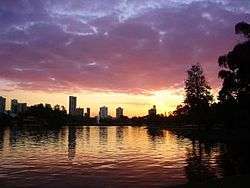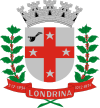Londrina
| Londrina, Paraná, Brazil | |||
|---|---|---|---|
| Municipality | |||
| The Municipality of Londrina | |||
|
Londrina in the afternoon | |||
| |||
| Nickname(s): Pequena Londres ("Little London") / Capital do Café ("Coffee Capital") | |||
 Location in Paraná | |||
 Londrina, Paraná, Brazil Location in Brazil. | |||
| Coordinates: 23°18′36″S 51°09′46″W / 23.31000°S 51.16278°WCoordinates: 23°18′36″S 51°09′46″W / 23.31000°S 51.16278°W | |||
| Country |
| ||
| State | Paraná | ||
| Mesoregion | Norte Central Paranaense | ||
| Microregion | Londrina | ||
| Founded | December 10, 1934 | ||
| Government | |||
| • Mayor | Alexandre Kireeff (PSD) | ||
| Area | |||
| • Total | 1,650.809 km2 (637 sq mi) | ||
| Elevation | 610 m (2,000 ft) | ||
| Population (2013) | |||
| • Total | 537,566 | ||
| • Density | 330/km2 (840/sq mi) | ||
| Demonym(s) | Londrinense | ||
| Time zone | BRT (UTC-3) | ||
| • Summer (DST) | BRST (UTC-2) | ||
| Postal Code | 86000-000 | ||
| Area code(s) | +55 43 | ||
| Website | Official website | ||
Londrina (Portuguese pronunciation: [lõˈdɾĩnɐ], literally Londonese) is a city located in the north of the state of Paraná, South Region, Brazil, and is 369 km away from the capital, Curitiba. Londrina was originally explored by British settlers, and then officially established in 1930 by a small group of Japanese and German settlers. It rapidly became the commercial, political, and cultural centre of the state’s northern pioneer zone.[1] The city exerts great influence on Paraná and Brazil's south region. Londrina has approximately 500,000 inhabitants, being the second largest city in Paraná and the fourth largest city in the Southern Region of Brazil (after Curitiba, Porto Alegre and Joinville).
The city has an estimated population of 543,003 (IBGE, Sala de imprensa[2]) and 818.300 in its metropolitan area.(IBGE, Sala de imprensa[2]) It is a regional centre and is made up of commerce, services, agro-industries, and universities, including the State University of Londrina and the Federal Technological University of Paraná.
Demography
The city was named after British entrepreneurs who launched railroad stations in the region to ease the transportation of coffee grains from northern Paraná and southern São Paulo states to the port of Santos. The word Londrina, literally meaning "Londoner" or perhaps "Little London", pays homage to the British capital (Londres in Portuguese), since a Londoner cotton company, Paraná Plantations Limited, made the original investment to settle in this area. The city's population consists of descendants of those settlers, mainly from England and Scotland, plus Portuguese, Japanese, Italian, German, Polish, African, Spanish, Native, Lebanese, Ukrainian and Bulgarian Brazilians, as well as some Brazilians from other cities or states.
| Color/Race | Percentage |
|---|---|
| White | 74.2% |
| Pardo (Brown/Mixed race) | 18.3% |
| Asian | 3.6% |
| Black | 3.4% |
| Indian (Native American) | 0.3% |
Fonte: Censo 2000
| Historical population | ||
|---|---|---|
| Year | Pop. | ±% |
| 1900 | 509 | — |
| 1910 | 976 | +91.7% |
| 1920 | 1,483 | +51.9% |
| 1930 | 27,475 | +1752.7% |
| 1940 | 65,889 | +139.8% |
| 1950 | 71,321 | +8.2% |
| 1960 | 136,401 | +91.2% |
| 1970 | 347,544 | +154.8% |
| 1980 | 403,005 | +16.0% |
| 1990 | 385,580 | −4.3% |
| 2000 | 447,065 | +15.9% |
| 2009 | 510,707 | +14.2% |
| 2010 | 506,645 | −0.8% |
| 2011 | 511,278 | +0.9% |
| 2012 | 515,707 | +0.9% |
| 2013 | 537,566 | +4.2% |
| 2014 | 543,003 | +1.0% |
Climate
According to the Köppen-Geiger climate classification system, Londrina has a humid subtropical climate (Cfa).[3] Average annual precipitation is 1,622.6 mm (63.9 in). Mean average annual temperature is 20.62 °C (69 °F).
| Climate data for Londrina (1961–1990) | |||||||||||||
|---|---|---|---|---|---|---|---|---|---|---|---|---|---|
| Month | Jan | Feb | Mar | Apr | May | Jun | Jul | Aug | Sep | Oct | Nov | Dec | Year |
| Record high °C (°F) | 37.3 (99.1) |
37.5 (99.5) |
36.7 (98.1) |
34.9 (94.8) |
32.0 (89.6) |
31.0 (87.8) |
31.3 (88.3) |
33.3 (91.9) |
37.6 (99.7) |
36.5 (97.7) |
39.0 (102.2) |
39.3 (102.7) |
39.3 (102.7) |
| Average high °C (°F) | 30.0 (86) |
30.1 (86.2) |
29.8 (85.6) |
28.0 (82.4) |
25.1 (77.2) |
23.5 (74.3) |
23.8 (74.8) |
25.8 (78.4) |
26.9 (80.4) |
28.1 (82.6) |
29.4 (84.9) |
29.3 (84.7) |
27.5 (81.5) |
| Daily mean °C (°F) | 23.9 (75) |
24.1 (75.4) |
23.4 (74.1) |
21.3 (70.3) |
18.3 (64.9) |
16.7 (62.1) |
16.7 (62.1) |
18.4 (65.1) |
20.0 (68) |
21.5 (70.7) |
22.9 (73.2) |
23.4 (74.1) |
20.9 (69.6) |
| Average low °C (°F) | 19.4 (66.9) |
19.5 (67.1) |
18.6 (65.5) |
16.0 (60.8) |
13.1 (55.6) |
11.5 (52.7) |
11.1 (52) |
12.4 (54.3) |
14.2 (57.6) |
16.0 (60.8) |
17.4 (63.3) |
18.6 (65.5) |
15.6 (60.1) |
| Record low °C (°F) | 12.0 (53.6) |
13.0 (55.4) |
8.2 (46.8) |
4.8 (40.6) |
0.0 (32) |
−2.8 (27) |
−0.5 (31.1) |
0.3 (32.5) |
3.0 (37.4) |
7.6 (45.7) |
8.8 (47.8) |
11.3 (52.3) |
−2.8 (27) |
| Average precipitation mm (inches) | 235.6 (9.276) |
173.5 (6.831) |
137.4 (5.409) |
107.8 (4.244) |
106.9 (4.209) |
96.5 (3.799) |
69.1 (2.72) |
60.0 (2.362) |
104.3 (4.106) |
177.1 (6.972) |
134.4 (5.291) |
230.3 (9.067) |
1,633 (64.291) |
| Average precipitation days (≥ 1.0 mm) | 14 | 12 | 11 | 7 | 7 | 6 | 5 | 5 | 7 | 10 | 9 | 13 | 106 |
| Average relative humidity (%) | 73 | 76 | 75 | 72 | 74 | 73 | 72 | 67 | 67 | 67 | 69 | 68 | 71.1 |
| Mean monthly sunshine hours | 193.1 | 190.0 | 216.2 | 229.8 | 217.4 | 209.0 | 232.5 | 223.7 | 176.6 | 183.8 | 194.5 | 197.9 | 2,464.5 |
| Source: INMET[4] | |||||||||||||
Economy

Agriculture continues to be Londrina's major economic activity, although its importance has diminished in recent years. Agricultural activity was diversified beyond coffee, and today corn, wheat, cotton, horticulture, beans, peanuts, rice, sugar cane, soy bean, and fruit plantations thrive due to the rich Northern Paraná/South Western São Paulo State "terra roxa" crimson soil. Although the city has increased its industrial park by adding weaving, textiles and agricultural factories, Londrina's main wealth continues to be agricultural production. Today, Londrina is also known for its commerce and service sectors. Moreover, real estate is another growing sector that has generated jobs and boosted even more the size of this city in Paraná.
It possesses one of the largest universities in the country, the State University of Londrina, as well as several private colleges.
The city is served by Londrina – Governador José Richa Airport.
Once a year, the city hosts the largest agricultural fair in Latin America, the Expo Londrina.
Soil
The fertile land of the region, "terra roxa" ("purple soil"), has this name due to a corruption and attempt to translate into Portuguese the term "terra rossa" ("red soil", in Italian), which Italian immigrants used to call it. The inhabitants of Northern Paraná state are often called "pé vermelho" ("red foot") because of their dust bowl-like region. The fertility of the soil is said to have originated in the biggest volcanic lava spill of the planet, known as The Spill of Trapp, that to a large extent occurred in the Center-South region of Brazil. During its golden era, (1920 to 1970), Londrina region accounted for 60% of all the coffee produced in the world, together with the west bank of the Paraná River,
Education
Portuguese is the official national language, and thus the primary language taught in schools. But English and Spanish are part of the official high school curriculum.
Colleges and universities
- Universidade Estadual de Londrina (UEL)
- Universidade Tecnológica Federal do Paraná (UTFPR)
- Pontifícia Universidade Católica do Paraná (PUC-PR)
- Universidade Norte do Paraná (UNOPAR)
- Centro Universitário Filadéfia (UniFil)
- Faculdade Pitágoras
- Faculdade Arthur Thomas (FAAT)
Metropolitan region of Londrina
Instituted by State Complementary Law 81 on 17 June 1998, the Metropolitan Region of Londrina includes the cities of Londrina, Cambé, Ibiporã, Sertanópolis, Bela Vista do Paraíso, Jataizinho, Rolândia, Tamarana and Arapongas totaling 750 thousand inhabitants.
Religion
The city is the seat of the Roman Catholic Archdiocese of Londrina.
The city is home to two stakes of The Church of Jesus Christ of Latter-day Saints as well as the home of the Brazil Londrina Mission, which encompasses northern Paraná and some of São Paulo.
Sports
The city's football clubs include Londrina Esporte Clube, founded in 1956, and the Associação Portuguesa Londrinense founded in 1950. They play at Café stadium, a 45,000 spectator capacity stadium.
Inesul/Londrina, owned by INESUL - Instituto de Ensino Superior de Londrina, an higher education institution, is a city's major basketball club and competes in the Campeonato Brasileiro de Basquete.
People
- Everson Maciel, footballer
- Flávia de Oliveira, model
- Giovane Élber, footballer
- Rafinha, footballer
- Jádson, footballer
- Naldo, footballer
- Fernandinho, footballer
- Michelle Alves, model
- Victor Lazzarini, composer
- Gilberto Godoy (Giba), volleyball player
- Rogério Romero, swimmer
Twin towns
 Modena, Italy
Modena, Italy Toledo, United States
Toledo, United States
References
- ↑ Londrina Encyclopædia Britannica、8-22-2013
- 1 2 http://saladeimprensa.ibge.gov.br/noticias?view=noticia&id=1&busca=1&idnoticia=2704
- ↑ "Climate: Londrina - Climate graph, Temperature graph, Climate table". Climate-Data.org. Retrieved 2 September 2013.
- ↑ "NORMAIS CLIMATOLÓGICAS DO BRASIL 1961-1990" (in Portuguese). Instituto Nacional de Meteorologia. Retrieved 5 September 2014.
External links
| Wikimedia Commons has media related to Londrina. |
 Londrina travel guide from Wikivoyage
Londrina travel guide from Wikivoyage- Official website (Portuguese)
- Official homepage (English)


